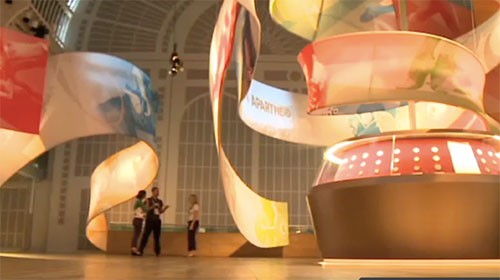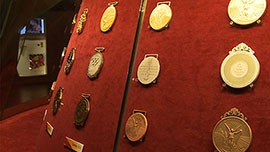Cronkite News has moved to a new home at cronkitenews.azpbs.org. Use this site to search archives from 2011 to May 2015. You can search the new site for current stories.
Exhibition gives London visitors a look at history, spirit of the Olympics
LONDON – In 1900, Charlotte Cooper of Great Britain became the first female to win an Olympic gold medal. A century later, Kelly Holmes of Great Britain became the third woman in Olympic history to win the 800- and 1,500-meters in the same games.
Their stories inspired people from all over the globe. Today they are preserved in the exhibition “The Olympic Journey: The Story of the Games” at the Royal Opera House in Covent Garden.
The exhibition, a collaboration between the Olympic Museum in Lausanne, Switzerland, the Royal Opera House and BP, celebrates human strength and endeavor and the uniting of the world through sports.
“The exhibition is about the Olympic soul, the Olympic spirit, in a way behind the scenes,” said Francis Gabet, curator of the Olympic Museum in Lausanne. “Here in London, you see big events, big champions, big crowds, but to go (and experience it), it’s a journey. It’s a journey for the whole movement that began many, many years ago in ancient Greece.”
Free to the public during the Summer Games, the exhibition gives a historical rundown of the Olympics from its creation in 776 B.C. and features artifacts, images and personal stories of 16 Olympic heroes through the ages.
Antoine de Navacelle, great nephew of Pierre de Coubertin, founder of the modern Olympic movement, opened the exhibition July 28, a day after opening ceremonies. Upon entering the Royal Opera House, guests experience the origins of the Ancient Olympic Games through multimedia storytelling of the athletics, combat and chariot races. As visitors move from room to room, they experience an Olympic timeline, from the ancient to the modern games.
“It brings it to life,” said Wendy Cruickshank, visiting from Scotland with her daughter, “especially when you go back into all the ancient stuff. It sort of sets the scene and all the important things that have happened which have transformed the Olympic Games, the women being involved and black Americans. It’s super, really super. It’s just an amazing thing to see and just puts it all into perspective.”
Every Summer Olympic torch since 1936 lines the long hallway leading to a grand room. Inside, Olympic memorabilia and photos cover the walls centering around a case displaying the Summer Olympic medals from 1896 to 2012.
In the same room, the walls and banisters hanging from the rafters are lit up with videos of past competition, athlete interviews and presentations of gold medals.
Throughout “The Olympic Journey,” guests also learn how the five rings represent the original five countries that competed in the games. Before entering the final room, visitors hear and see de Coubertin’s famous words: “The important thing in life is not the triumph but the fight. The essential thing is not to have won but to have fought well.”
A similar exhibition is planned for the 2016 Summer Olympics in Rio de Janeiro.
“I think they should take it around to other places so people can see it,” Cruickshank said. “It’s suitable here because the games are here, but I think the world needs to see it because of the meaning behind (it). Not just actually seeing it, but the meaning behind the Olympic Games, which is to bring the world and unite world, and I think you forget that. You watch the sport, you forget that what it’s done is united all these countries together.”











